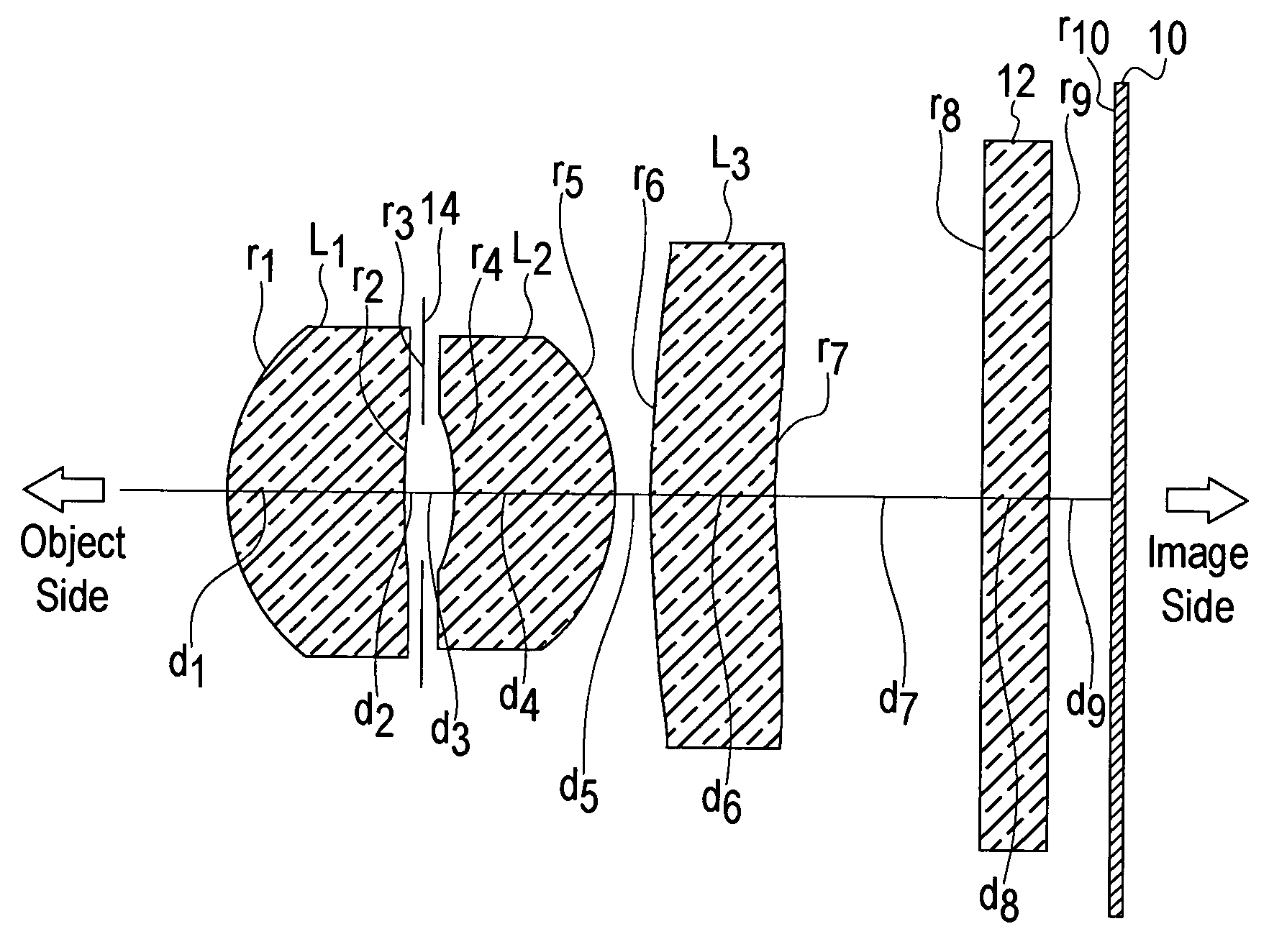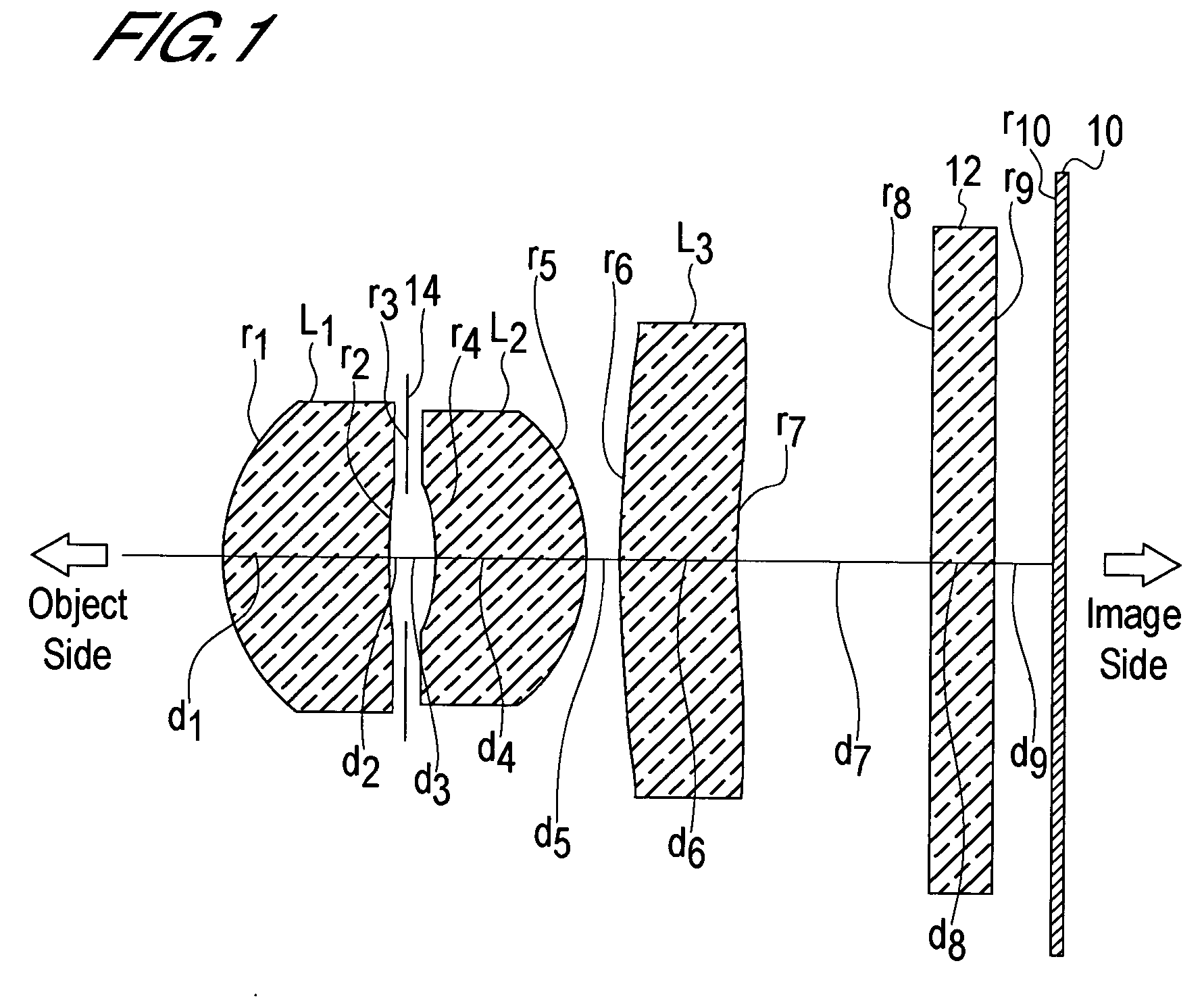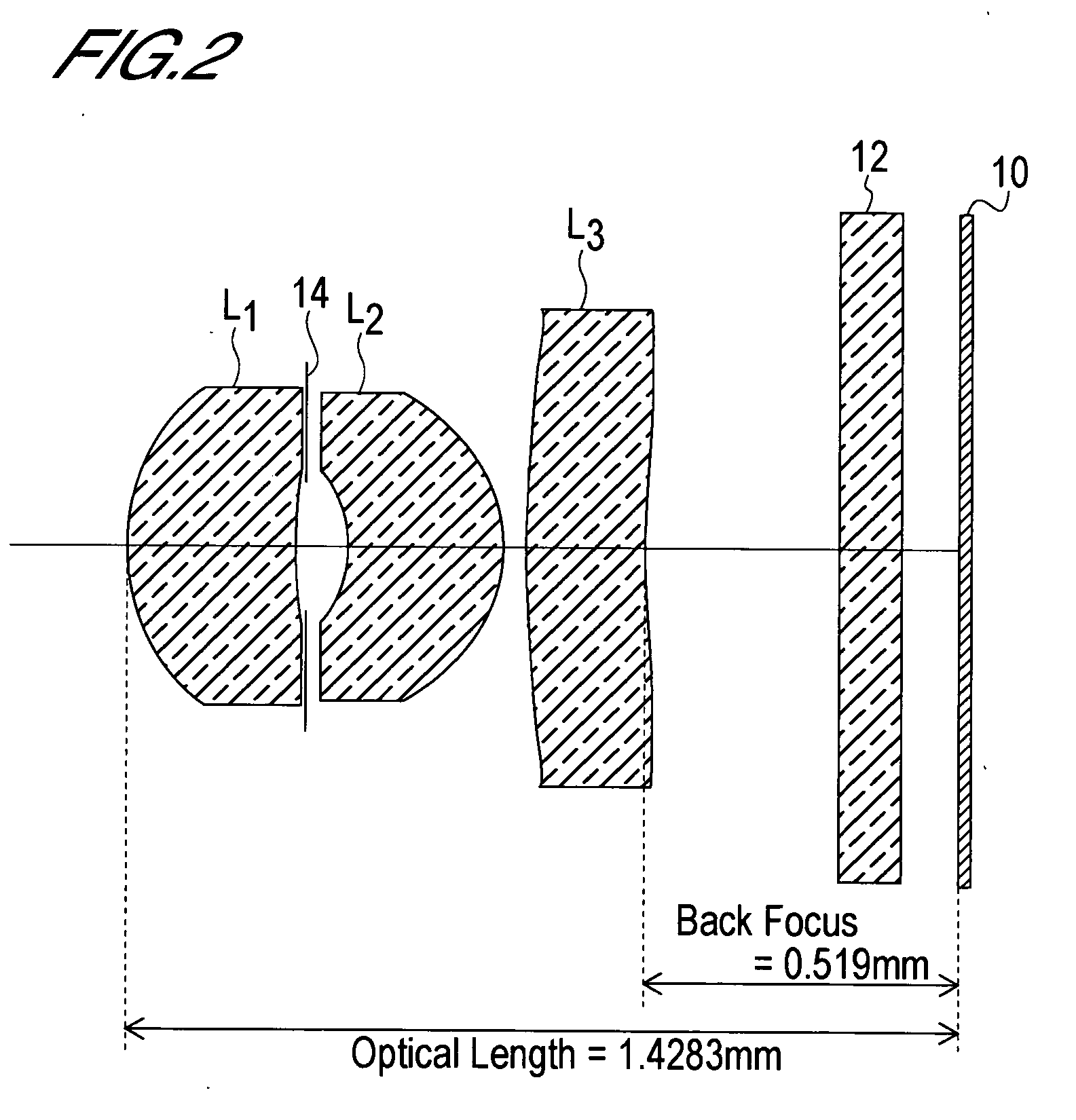Imaging lens
a technology of imaging lens and optical length, which is applied in the field of imaging lens, can solve the problems of inability to produce compact lenses, inability to reduce the effective diameter of third lenses, etc., and achieves the effect of high degree of reliability and convenient implementation of inventions
- Summary
- Abstract
- Description
- Claims
- Application Information
AI Technical Summary
Benefits of technology
Problems solved by technology
Method used
Image
Examples
first embodiment
[0106] (A) The object-side curvature radius r1 of the first lens L1 is r1=0.391 mm. [0107] (B) The image-side curvature radius r2 of the first lens L1 is r2=0.806 mm. [0108] (C) The back focus bf is bf=0.519 mm. [0109] (D) The distance in air from the object-side surface of the first lens L1 to the imaging surface, or in other words the optical length d, is d=1.4283 mm. [0110] (E) The interval D2 between the first lens L1 and second lens L2 is D2=d2+d3=0.0899 mm. [0111] (F) The thickness D3 at the center of the second lens L2 is D3=d4=0.2745 mm. [0112] (G) The focal length f1 of the first lens L1 is f1=1.16 mm. [0113] (H) The focal length f2 of the second lens L2 is f2=1.16 mm. [0114] (I) The focal length f3 of the third lens L3 is f3=−3.7 mm.
[0115] Hence [0116] (1) r1 / r2=0.391 / 0.806=0.4851 [0117] (2) D2 / f=0.0899 / 1.00=0.0899 [0118] (3) D3 / f=0.2745 / 1.00=0.2745 [0119] (4) d / f=1.4283 / 1.00=1.4283, and [0120] (5) bf / f=0.519 / 1.00=0.519.
[0121] Thus the lens system of the first embodiment...
second embodiment
[0130] (A) The object-side curvature radius r1 of the first lens L1 is r1=0.351 mm. [0131] (B) The image-side curvature radius r2 of the first lens L1 is r2=0.608 mm. [0132] (C) The back focus bf is bf=0.470 mm. [0133] (D) The distance in air from the object-side surface of the first lens L1 to the imaging surface, or in other words the optical length d, is d=1.3714 mm. [0134] (E) The interval D2 between the first lens L1 and second lens L2 is D2=d2+d3=0.0906 mm. [0135] (F) The thickness D3 at the center of the second lens L2 is D3=d4=0.2768 mm. [0136] (G) The focal length f1 of the first lens L1 is f1=1.13 mm. [0137] (H) The focal length f2 of the second lens L2 is f2=1.19 mm. [0138] (I) The focal length f3 of the third lens L3 is f3=−3.77 mm.
[0139] Hence [0140] (1) r1 / r2=0.351 / 0.608=0.5773 [0141] (2) D2 / f=0.0906 / 1.00=0.0906 [0142] (3) D3 / f=0.2768 / 1.00=0.2768 [0143] (4) d / f=1.3714 / 1.00=1.3714, and [0144] (5) bf / f=0.470 / 1.00=0.47.
[0145] Thus the lens system of the second embodimen...
third embodiment
[0153] (A) The object-side curvature radius r1 of the first lens L1 is r1=0.353 mm. [0154] (B) The image-side curvature radius r2 of the first lens L1 is r2=0.611 mm. [0155] (C) The back focus bf is bf=0.454 mm. [0156] (D) The distance in air from the object-side surface of the first lens L1 to the imaging surface, or in other words the optical length d, is d=1.3746 mm. [0157] (E) The interval D2 between the first lens L1 and second lens L2 is D2=d2+d3=0.0909 mm. [0158] (F) The thickness D3 at the center of the second lens L2 is D3=d4=0.278 mm. [0159] (G) The focal length f1 of the first lens L1 is f1=1.14 mm. [0160] (H) The focal length f2 of the second lens L2 is f2=1.19 mm. [0161] (I) The focal length f3 of the third lens L3 is f3=−3.79 mm.
[0162] Hence [0163] (1) r1 / r2=0.353 / 0.611=0.5778 [0164] (2) D2 / f=0.0909 / 1.00=0.0909 [0165] (3) D3 / f=0.278 / 1.00=0.278 [0166] (4) d / f=1.3746 / 1.00=1.3746, and [0167] (5) bf / f=0.454 / 1.00=0.454.
[0168] Thus the lens system of the third embodiment s...
PUM
 Login to View More
Login to View More Abstract
Description
Claims
Application Information
 Login to View More
Login to View More - R&D
- Intellectual Property
- Life Sciences
- Materials
- Tech Scout
- Unparalleled Data Quality
- Higher Quality Content
- 60% Fewer Hallucinations
Browse by: Latest US Patents, China's latest patents, Technical Efficacy Thesaurus, Application Domain, Technology Topic, Popular Technical Reports.
© 2025 PatSnap. All rights reserved.Legal|Privacy policy|Modern Slavery Act Transparency Statement|Sitemap|About US| Contact US: help@patsnap.com



